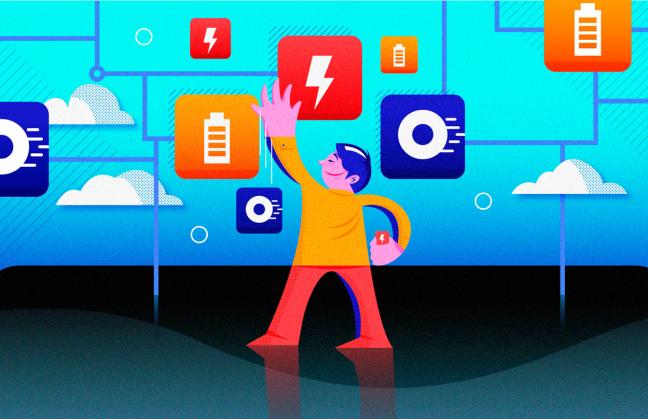The iPhone effect: An Impact on Electricity and Transportation
Horizontal integration into a single digital platform could define the future of these sectors

The coronavirus crisis has demonstrated, on the one hand, the fragility of the economy in the face of events of exponential magnitude, and, on the other hand, the advantages of technology as an engine of progress — much of the economic activity may continue during the quarantines thanks to the digitization of many processes. We are in times of uncertainty, vulnerable to multiple types of crisis that can disrupt entire sectors, both in the short and long term.
For example, in the energy and transport sectors, the shock in oil demand caused by the coronavirus crisis, combined with a supply shock unleashed by the price war between Russia and Saudi Arabia, is a temporary impact (up to one year, based on recent history). But there are medium and long-term trends that will radically transform business models.
Once the Covid-19 crisis is behind, the world will continue to face the climate emergency and countries will have to meet the climate goals established in the Paris Agreement. This implies the decarbonization of the electricity sector, as well as the electrification of other sectors of the economy, such as transportation, which is heavily dependent on fossil fuels.
However, both the electricity and transportation sectors are navigating major technological transformations that will change the way we consume these services. Therefore, the question we address in our research is whether these technological changes will help or hinder the process of electrification in the transportation sector.
In the electricity sector, the combination of photovoltaic panels, batteries and smart appliances for demand response will allow households to become self-sufficient and even disconnect altogether from the power grid, which represents a threat to the traditional model and viability of utilities (both public and private).
On the other hand, when it comes to transportation, the combination of ride-sharing apps (Uber, Lyft, etc.), electric vehicles (Tesla) and automation (Google) may discourage the car ownership model, which is the dominant urban transportation model, and instead “consume” mobility as a per trip service.
Given the speed at which these technological innovations unfold, it is hard to know what the future holds for these two sectors, which undoubtedly poses major challenges that are not without risk. How are these changes?And what business opportunites might be open? In order to address these questions we we published a research paper called The “iPhone effect”: The impact of dual technological disruptions on electrification (Competition and Regulation in Network Industries, 2019), cowritten by Lester C. Hunt, from the University of Portsmouth, along with Héctor López-Ruiz and Baltasar Manzano, researchers from the King Abdullah Petroleum Studies and Research Center (KAPSARC).
We noted that , interestingly, the developments in both sectors are the result of the combination of three technologies. We call this the “iPhone effect”. The iPhone was originally so disruptive because it bundled at least three different technologies in one device: a telephone, a music player, and a computer that could access the Internet. Therefore, we explored whether the combination of three technologies in the electricity sector, paired with three new transportation technologies, could create an even bigger “iPhone effect”.
In this paper we come to the conclusion that both the electricity and transportation business models will transform towards offering aggregated services, marketed as subscriptions and traded on digital platforms. This will provide an opportunity to generate data regarding consumer behavior, which, on its own, could provide an additional revenue stream for electricity and transportation companies. Since the cost of integrating both businesses into a digital platform is relatively low, we believe that, in the future, both services could be offered by a single company, the same way Amazon started as bookstore that would later incorporate DVDs and now offers an endless variety of products.
Democratizing electricity
This transition the electricity sector is undergoing has an impact on regulatory and business frameworks. The deployment of renewable energies, the rapid development of on-site generation, batteries, photovoltaic panels and smart appliances for demand response, can help reduce the reliance on the electric grid, thereby promoting household energy independence and the decentralization of the system. This phenomenon could pave the way for new players to enter the market, while also reducing the role of public utilities. Moreover, these innovations lead to reconceiving products as services:
- De-commoditization: Instead of buying electricity as a commodity, consumers can purchase a product differentiated by its intangible attributes, such as “clean” or “reliable” (two of the most valued features of any electricity service).
- Servitization: Instead of buying kilowatt-hours, customers could buy the service provided by electricity, such as cooling or heating.
Mobility as a service
These new technologies in the transportation sector challenge the dominant car ownership model in favor of a new model in which mobility is seen as service. Investing in a car becomes expensive and unnecessary when one can receive the same benefits of car ownership but with flexibility and at a lower price thanks to ride-sharing apps. In this new model, a vehicle increases its efficiency by making more trips during its lifespan, reducing the average price per trip. This is coupled with the fact that electric vehicles have lower maintenance costs and that, eventually, autonomous vehicles and connectivity could further reduce the amount of time cars remain idle. Yet, it is not lost on anyone that this model could be detrimental to the automotive industry.
Potential synergies
The following are the potential synergies of both sectors:
- Improving battery storage: Batteries are necessary for storing energy, whether in electric cars or in energy-independent households. Improving battery storage capacity, as well as reducing its cost, would overall result in lower prices and economies of scale in both sectors. Furthermore, electric vehicles could contribute to the development of a smart grid by charging during off-peak hours.
- Platforms, subscriptions, and horizontal integration: Electricity and transportation could be traded on digital platforms and offered as subscriptions or memberships where these services could be combined in a package. For instance, electricity could be traded in fixed-price schemes that reflect the user’s willingness to pay in order to have access to a reliable service. Mobility, on the other hand, could be traded as subscriptions for a given number of scheduled trips, with unscheduled add-ons.
- Data generation: With the inherent data generation that comes with digital technologies, companies can predict consumer behavior. This data can be monetized by developing combined electricity and transportation products.
- Local focus: Both on-site distribution and shared mobility are primarily urban developments. As such, municipal legislation will have a decisive impact on promoting or halting this development.
Ultimately, the horizontal integration of these two sectors into a single platform would allow companies to achieve economies of scale, reduce transaction costs and collect additional data, thus generating a ripple effect that could lead to an increased demand for mobility and electrification.



